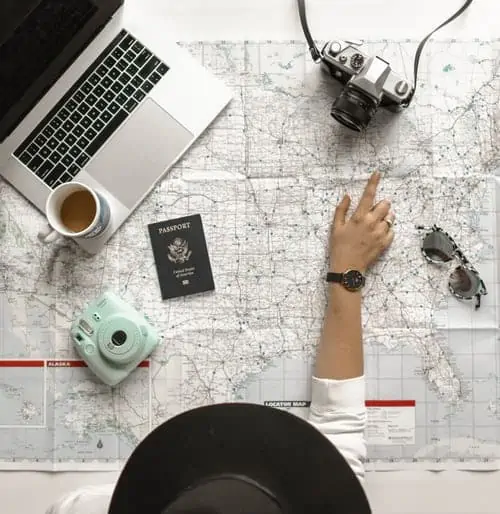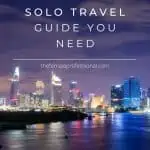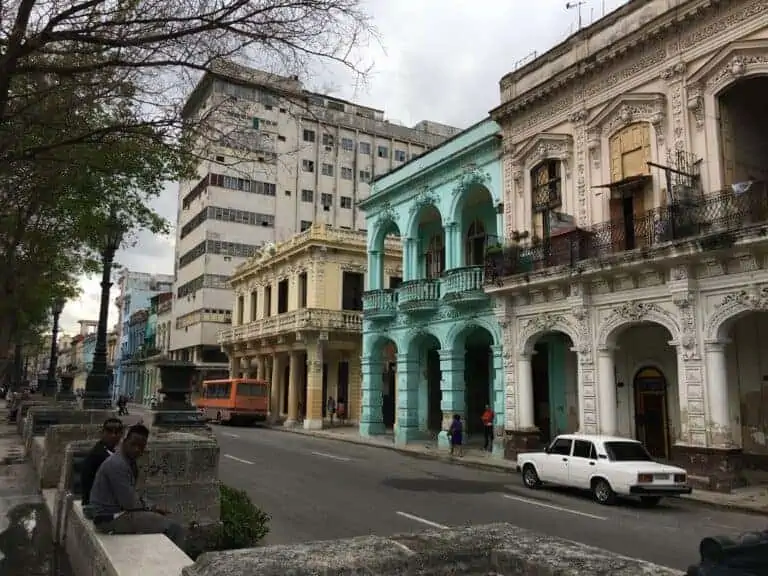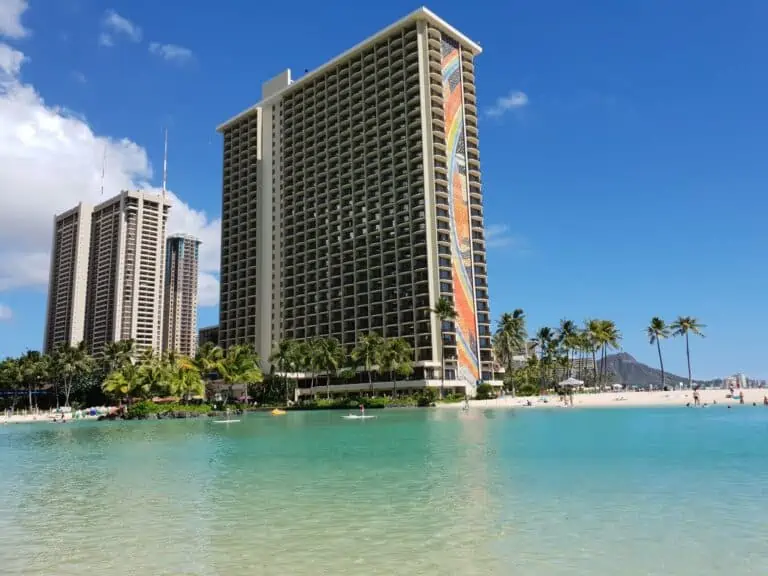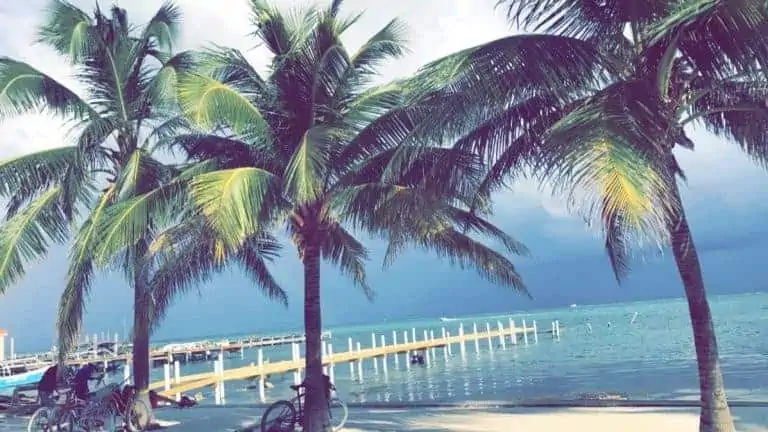Your Solo Travel Guide: Budget, Pack, Prepare & GO!
Solo travel is a great way to not only learn about the world, but also discover who you are, and push the boundaries of your comfort zone. However, solo travel can get intimidating (there’s so much to do to prepare!) and expensive as you no longer have anyone to split costs with. Travel hacks can help.
This guide will help you figure out how to budget for a solo trip and save money, how to pack so that you’re efficient, and will go over some things you must do to be prepared. Also, we’ll cover some benefits of solo travel and why everyone should do this at least once. PLUS, tips for what you can do by yourself once you’ve arrived! Let’s get started.
Choosing a Budget-Friendly Destination
There are plenty of budget-friendly destinations for traveling solo. Some examples include:
- Almost anywhere in South or Central America
- The Caribbean
- SE Asia
- The Pacific Islands, including the Philippines, Indonesia, and Malaysia
- Eastern Europe
- Parts of Africa
The downside to some of these is the length of the flight, which means the price of the flight may be expensive, but as we’ll go over below, there are ways to make it happen and not break the bank! Other areas, including Western Europe, parts of Africa, Australia, and parts of Asia, maybe a little more expensive, however, if you budget for them and save ahead of time, they are doable as well.
Things to Consider When Planning Your Solo Trip
Figure out how much time off you have. This will help you quickly eliminate specific areas of the world that may require longer stays or take longer to get to.
Determine How Much Money You Have to Spend
Depending on how much time you have available, and what your travel budget is, you can narrow down vacation spots. For instance, destinations further away may have more expensive flights. Also, consider using travel credit cards and travel points to pay for things (especially useful if you have time to get a new card and plan).
Look for Travel Deals
Another way to find a destination to fit your budget is to look up travel deals. Many airlines offer discount fares to different destinations. That is especially helpful if your travel dates are flexible. See if your vacation time is in the offseason for any of those destinations, as traveling off-peak can save you a ton of cash on hotels and activities once you’re there.
Services like Scott’s cheap flights allow you to sign up for free and get deals directly to your inbox as they’re happening. You’ll see various travel dates for different destinations for super cheap. These offers last a limited time, however, it’s a great resource for getting destination ideas and scoring cheap tickets!

How to Save Money on Your Trip
Saving money doesn’t have to end at airfare. Once you’re there, there are ways to ensure you continue keeping and sticking within your budget.
Choose Lodging Carefully
If you have a budget that allows for it, then I recommend a centrally located hotel, even if it costs you a little bit more. That is because the benefits include not having to pay for public transportation because you can potentially walk everywhere, and easy access to food options and tour operators.
The best way to figure out central locations is to map out all the popular activities to do and then search for lodging in that area. Alternative options include Air Bnb, VRBO, Hostels, House swap, or couch surfing (if you know people who live there). Again, if possible, central locations work best because of their convenience, and you save on other costs.
On the flip side, depending on your destination and how long you’ll be there, you can look for lodging closer to the airport or with airport shuttle access. For instance, if you’ve got only one or two nights in a city and are planning on doing a tour (and very little self-exploring), then this may be a good option. You’ll save time and money on transportation to and from the airport.
Avoid the Single Supplement
You may note when booking your lodging, that the rates are for “per person, double occupancy”. If you choose that room and say, there’s only one person staying, the price for you goes up significantly. That is a penalty for solo travelers. However, there are ways to avoid it.
Some companies will match you with other solo travelers, or you can dig around find spots that don’t charge the supplement (often smaller boutique hotels don’t, or they have rooms made explicitly for solo travelers – this is the route I usually take)
Save on Transportation
Sometimes the highest public transportation cost is going to and from the airport. Look up ahead of time the best ways to do so; many cities in Europe, for instance, have great subway or metro systems.
In Japan, there was a bus that took us into the city. From there we took a taxi to the hotel. You can do the same research in regards to getting around when you reach your destination. In Vietnam, for example, some taxis are known to scam tourists. We found out about those ahead of time and made sure to avoid them.
Save on Food
Some hotels offer free breakfast. Take that into consideration when budgeting for your stay. Alternatively, if you end up getting an Airbnb or VRBO, then go grocery shopping and cook at least one of your meals at home. Street food is also a great option. You’ll taste local cuisine AND save money as it’s some of the most affordable cuisine available. Look up food spots ahead of time so you have an idea of how much your meals could cost you.
Save on Things to Do
Check out your destination’s tourism board. It will usually display events happening in your area, many of them free or discounted, or you purchase a day pass and get entry everywhere at a discount. For instance, in Paris, the Louvre, for part of the year, has free visits available the first Sunday of every month. It takes a little digging and research, but the savings can be significant!
Packing Checklist for Solo Travel
I highly recommend you create a travel checklist so that you can keep track of everything. Also, try to limit your luggage to a carryon and backpack. You’ll save yourself time at the airport checking in and at the baggage claim, AND you’ll save on possible fees (some taxis will charge you for putting a suitcase in your trunk). Plus, having only two, well-packed items will save you the headache of lugging something large and bulky with you everywhere you go (this is especially helpful with long multi-destination trips)
So, what should you be packing? The essentials. Plus, you should make sure that everything you pack is everything you will use while abroad.
Packing Tips for clothes and souvenirs
A capsule wardrobe ensures that everything you pack will match with each other, which increases the number of outfits you can get from a week’s worth of clothes. I’ll also add that you should pack items that can double up in usage. For instance, if you’re going somewhere warm and tropical, then pack dresses that will work as both daywear and also coverups.
Roll Your Clothes to Save Space
That actually will save you a lot of space.
Use Packing Cubes to Save Space and Stay Organized
Packing cubes are a great way to keep your essentials organized, and also separated, making it easier for you to find. I’d also recommend that you roll your clothes when you place them in the packing cubes. Check out these from Amazon, I have this set and take it with me everywhere.

Pack a Collapsible Duffel
A collapsible duffel is one that collapses rolls and fits into itself. Take one with you and open it up on the way home to fit in all those newly bought souvenirs. I have this one from Amazon:

Must Have Emergency Kit Supplies for Solo Travel
Anything can happen while you’re abroad, and it can be scary when you’re by yourself. Being prepared with a small emergency kit has always gone a long way towards helping me feel better. Here are some things you should consider putting into yours:
- First aid box with bandaids, bandages, and antibacterial ointment
- Medications:
- Antihistamines – Benadryl, Zyrtec, etc.
- Pain killers -Tylenol, Ibuprofen, etc.
- Sleep aids (helps with jet lag !)
- Anti-diarrheals (like Immodium)
- Antacids – Pepcid or Maalox chewable tablets
- Cold medication – Dayquil, Nyquil tablets, Sudafed, cough drops
- Motion sickness tablets – Dramamine
- Lubricating eye drops
- Hydrocortisone cream
Many of these are available in small travel packs that you can get at your local drug store. What do I do? I have many of these at home, so I’ll grab a few of each and stick them either in the same bottle to save space, or place them all in a single Ziploc bag and make it a “kit”.
Random Items That You Always Forget
Many people forget these next few items. But now, you’ll remember!
- Sunglasses
- Headphones (especially noise-canceling ones)
- Sunscreen
- Bug Spray
- An alternative to bug spray: OFF wipes, easy to pack, use em and toss em
- Refillable water bottle
This is my favorite water bottle:

Things You Must Have When Traveling, Solo or Otherwise
- RFID wallet to protect your identity
- Cash
- Updated passport (+/- visa)
- Personal and student I.D. (take your student I.D.s if you have them, you’ll get great discounts!)
- All the travel accessories to help you out!
Check out this wallet below!

Things You Must do before you travel abroad
Preparation is key. When you’re deciding on solo travel, it’s even more essential to take specific steps to ensure your safety before you go and to make your solo travel experience smoother. Here are some things you MUST DO before you go:
Enroll in the STEP Program
That stands for the Smart Traveler Enrollment Program. How it works:
- You sign up before you travel anywhere outside of the U.S.
- Your information is saved with the State Department – which means the government knows where it’s citizens are at any given time.
- If an issue arises in a country you are visiting, they will be able to communicate with you directly. For instance, you’ll get updates on travel information, flight availability, and safety concerns.
I have a colleague who got stuck abroad at the beginning of the COVID-19 pandemic lockdown, and she said this was the single most helpful thing in regards to knowing how to get home and when it would happen.
Enroll in TSA Precheck and Global Entry
Many travel credit cards include the cost of these. The transportation security administration (TSA) precheck and Global entry (customs and border patrol) each costs $100 for five years. That pays for your background check, and you must do an in-person interview for each. With Precheck, you will save time during check-in by skipping long security lines, and with Global entry, you will save time coming home by skipping customs lines. The interviews can be done at any airport with a TSA/Global entry office. After you fill out your form online, you will receive a list of places where you could make your interview appointment, so rest assured you will not have to dig in and research where to go. The time saved by having these two things is invaluable.
Double Check Your Destination Information
Check the State Department’s site on Travel Advisories, which details the safety level of your destination. That gets updated frequently, and if there’s a travel advisory, it will tell you what to look for OR what area of your destination country is affected. Often, local conflicts can make it more dangerous to travel to certain parts of the world. Knowing the status beforehand can help you with planning and making informed decisions about what parts of the country to visit, OR if you should go to that country, to begin with.
Also, double-check whether or not you need a visa for your destination. If you are a U.S. passport holder, you will be allowed to travel to most countries without a visa. However, some countries require a visa. Depending on the country, you may be able to get it beforehand and pay a fee. You can usually do this online. Sometimes you’ll have to send your passport into the embassy.d Or you can obtain and pay for the visa at the airport when you arrive. More information on that can be found here.
Note Down Important Numbers
In the era of cellphones and wifi, this information can either be stored on your phone or looked up online. HOWEVER, I have been in situations where I didn’t have either option because my phone was dead or the wifi wouldn’t connect (and in countries like Cuba, you never get wifi, to begin with). So, a great back up is to write this information down and keep it with you at all times (or take a picture).
- Hotel name, address, and phone number
- U.S. Embassy address and phone number
- Your parents or significant others’ cell phone numbers
Also, take a picture of your passport (and take a couple of hard copies). If anything gets stolen, your only ticket home is your passport, and the easiest way to get a new one is to show a picture or a copy of the original.
Tips on Safety During Solo Travel
There are several things to consider when traveling abroad by yourself (especially for female solo travelers). Even if your destination is known for being safe, you may still find yourself in unsafe situations. This section is meant to give you some friendly reminders about how to travel safely and smartly. In addition to the safety measures I’ve mentioned already, consider these as well:
Stay Away from Known Crime Areas
Pretty obvious, however, do keep this in mind. Do some research before you go, and once you’re there, talk to your tour guides and ask them about different parts of the country/city you’re visiting. Get feedback from the locals about where to go and what to do. As always, trust your instincts no matter what anyone tells you, but this is a great starting point to get a lay of the land.
Once you know where NOT to go, DON’T GO. As a tourist, you will stand out, and you will just be asking for trouble. Plus, during solo travel situations, you will have no one to rely on or ask for help, so it is essential to be doubly safe.
Check In Regularly with Family and Friends
Let your people know where you are and how you’re regularly doing. If not via phone, then via email, shoot them regular updates. It’s an excellent way for them to keep track and makes it quicker for them to realize if something is wrong if/when you don’t check in on time. I’d also recommend you send them a copy of your itinerary so that they know where you’re supposed to be.
Keep Valuables with You at All Times
Even if you’re with a group tour and are just hopping to the bathroom, take your purse/wallet/valuables with you. I have heard horror stories of people “trusting” their groups, only to come back from a bathroom break to find their bags have been stolen, including passports, and now they’re stuck. Don’t let that happen to you.
Also, whatever bag you carry: ensure it has a zipper, don’t keep your cellphones/wallets in your back pockets, and don’t wear fancy jewelry (once, in India, I saw a motorcyclist drive by and grab and yank a ladies’ gold chain off her neck – this stuff happens)
Don’t Get Lured into Private Areas
Salespeople will hound you and offer you great deals on designer this and designer that, OR offer you an opportunity to get some excellent locally made goods….you just have to follow them down an alley into some house.
Hard pass.
Do. Not. Follow. There is no deal, no object or good, worth going into an unknown by yourself. Turn around and walk the other way, or demand that they bring it to you. Of note, this is not something that happens everywhere, just something to keep in mind if you do happen to be somewhere where this occurs.
Consider Self-Protection
Solo travel can be scary in that you are alone and have no one to back you up. We are taught from childhood that there’s “safety in numbers”. Well, solo travel takes that safety net away. Consider taking some Mace, or an equivalent, with you. Trust no one, of course, but also have a way to get yourself out of sticky situations.
Mace is one option; another is to take a set of keys and put a key between each finger and make a metal claw of sorts. I do this when I feel something is off and always feel better for doing so. Be careful with purchasing an actual claw because you can get stopped at the airport for having one (I have a friend who spent the night in airport jail for this, in the United States)
Dress Appropriately
In some parts of the world, this matters. Look up local customs so that you pack appropriately and can blend in once you arrive (again, this tends to affect solo female travelers disproportionately).
Tips on What to Do Once You’ve Arrived
You’ve budgeted, you’ve prepared, you know how to be safe, and now you’re at your destination!! Let the fun begin! Here are some ideas for how you can spend your time abroad and get the most out of your solo travel experience.
Take Part in a Tour
This is an easy thing to do by yourself and a great way to get your feet wet, roaming around a new city or town. While it’s daunting climbing onto a tour bus and asking strangers if you can sit next to them, it’s also a great way to meet new people.
Booking a tour on at least one day of your trip also allows you to get the lay of the land, and learn some history and background of your destination. You can also use this opportunity to speak to your tour guide about recommendations and safe areas to explore. (pro tip: some companies offer solo travel tours specifically to help those who are by themselves meet other people!)
Go to a Bar/Out to Eat
Do not eat in your hotel room by yourself! Instead, use the recommendations you’ve been given to find a local restaurant, walk-in, and take a seat. No one is staring at you; no one is judging. To make it easier, try going out for lunch where there’s outdoor seating. Choosing a less formal spot can make it less awkward, make it easier to speak with the waitstaff about local culture, and you can take a book or people-watch without issue.
Try Local/Authentic Cuisine
That goes hand-in-hand with the prior point. We tend to stay in our comfort zone, and so may gravitate towards food and restaurants that fit that zone. Instead, use this opportunity to branch out and experiment! Researching ahead of time is helpful here in regards to what specialty foods are unique to each country and city, but the best restaurant recommendations, I think, come from the locals. Once there, ask your hotel concierge or your tour guides.
Try Your Hand at Bargain Shopping
If you’re in a place that allows you to haggle for the best price, then go for it! Try and see if you can get the best price for the item you want. This is a great way to immerse yourself in the local culture and practice the language!
Figure Yourself Out
One of the greatest benefits of solo travel is that you have time for yourself, your thoughts, and your ideas. So use it to figure yourself out, deal with your stressors, and regain perspective on your life and career trajectory. Don’t be afraid of your thoughts; be absorbed in them so that you make the most of this time to yourself. The best solo trips include not just adventure and challenges, but also self-reflection and personal growth. You’ll go home a more confident, stronger, and content.
A Solo Travel Experience Is a Must for Everyone
It’s scary to go somewhere by yourself if you never have before. However, there is no better way to learn about the world and yourself than by pushing your boundaries and taking that scary first step. A tip for getting started for your first solo trip to make it a little easier: pick a country where there’s no language barrier. It can take a weight off your shoulders if you know that you speak the language and can ask for help without issue and make your first-time solo experience a bit less daunting.
In Summary
- Figure out your budget first, then pick your destination
- Pack lightly so that you save time and money
- Enroll in STEP, TSA precheck & global entry
- Double-check travel advisories
- Make sure you know the VISA requirements
- Pack all the necessities, including emergency kits, medications and contact information
- Stay safe when you’re there
- Most importantly: HAVE FUN and go for it with all the things you want to do!
Happy Travels! This article originally appeared on Your Money Geek and has been republished with permission.

